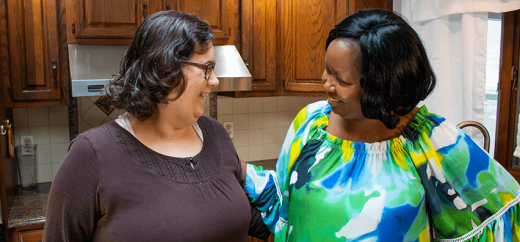Nonotuck Webinar Offers Guidance on Building Resilience Through Mindfulness
We all face times of stress in our lives, running into challenges that may seem insurmountable. If we are resilient, we can bounce back from adversity. But what if we’re not?
Jannelle Robinson, marketing and wellness coordinator for Nonotuck Resource Associates, Inc., recently presented a webinar on ways people can build their resilience using five different mindfulness techniques.
The webinar, entitled “Building Resilience Through Mindfulness: Five Tools for Staying Centered During Difficult Times,” was part of Nonotuck’s annual AFC (Adult Family Care) Summit.
Each year, Nonotuck hosts the AFC Summit to offer AFC provider organizations educational sessions and opportunities to network with other professionals in the field.
Due to the coronavirus pandemic, this year’s summit took place virtually, with all five sessions now available on Nonotuck’s website as webinars.
In her webinar, Robinson says resilience is the process of adapting well to or bouncing back from adversity and sources of stress. Some people are more resilient than others, but luckily resilience is a skill that can be practiced and learned.
“It’s not something that you have or you don’t,” Robinson says. “It’s something you can develop and build.”
The webinar focuses on walking attendees through five mindfulness tools: movement, meditation, breathing, intention setting and journaling. Mindfulness, she says, is “the awareness that arises from paying attention on purpose in the present moment and nonjudgmentally.”
According to Robinson, the tools can be used together or individually. “Notice which ones catch your interest or your intention.”
People may feel they don’t have time for a mindfulness practice, but the tools don’t have to take much time, and can have huge payouts, she says. For instance, using a mindful movement like a sun breath helps people coordinate their breath with their movements and creates an awareness of the body.
“It allows us to take us out of our heads and into our bodies,” Robinson says. “You can use movement to be your anchor in the present moment.”
She notes that running, swimming, and other activities can also be done mindfully. “You can turn your exercise routine that you already have into a mindfulness practice using the sensations in your body to bring you into the present moment.”
In addition to boosting awareness and resilience, mindful movement practices can also be beneficial for physical health, Robinson says, including improving cardiovascular health, bone density, balance, strength, digestive systems and improving sleep.
Other mindful practices, like meditation, can reduce stress, boost memory, and increase focus and immunity.
Most of the tools presented during the webinar take just a few minutes, but one can be done in seconds. That’s mindful breathing.
Robinson describes a “letting go” breath, in which a person inhales deeply through their nose, opens their mouth and exhales with a sigh. Designed to help release tension, a letting go breath be done anywhere.
“The focused breathing reduces emotional intensity and increases tolerance during stressful encounters,” says Robinson, who recommends using the breath when you begin feeling signs of stress or before entering a stressful situation. “It’s a great tool for building resilience.”
In addition to presenting the five tools, Robinson also talks about ways to establish a routine, including setting a reminder on a phone or calendar, or sharing your plan to use the tools with someone who can hold you accountable.
You can learn more about the five tools by watching the webinar. Robinson leads attendees through each of the tools individually and offers advice and tips on incorporating them into your life.


